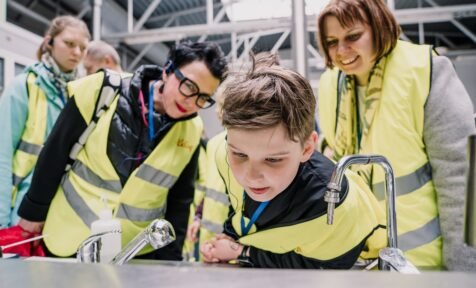The AI revolution is here. Ready or not, whether we want it or not, it is here. Its profound impact can already be observed and we must prepare for what is coming, particularly in education. However, the outcome of this impact, whether it proves to be beneficial or detrimental, depends not solely on technological advancements but primarily on the skills and knowledge possessed by the person using them.
By Jaan Aru, PhD — Associate professor at the University of Tartu
Dating back to the 1980s, we have known that the most effective approach to teaching and learning involves the presence of a personal tutor. Acting as a guide, this tutor can monitor the learning process, notice the mistakes and knowledge gaps, and tailor instruction to address individual needs. Despite the long-standing recognition of the effectiveness of personalized tutoring, its practical implementation has remained elusive, until now.
AI: The new age tutor
The advent of AI, especially large language models (like ChatGPT), presents an unprecedented opportunity to finally realize the vision of a personalized tutor system in education. AI technologies can replicate the qualities of a human tutor, to offer tailored guidance and support to learners. With the ability to analyze vast amounts of data and draw meaningful insights, AI can, in principle, adapt instructional content, identify knowledge gaps, and provide targeted recommendations for improvement. However, it is essential to acknowledge that achieving synergy between the learner and the AI tutor is more complex than it may initially appear. Crucially, we must recognize that the impact of AI on education is not only dependent upon the technology itself; it also hinges significantly on the user’s competence. Technology alone cannot solve educational challenges if the learners are not adequately prepared to harness its potential.
To understand why this is the case, let us consider the analogy of cars. Undoubtedly, cars are remarkable and valuable technological inventions. However, their usefulness is contingent upon the individuals’ knowledge and skill to drive them. Imagine if we were to provide cars to all 10-year-olds without any form of instruction or guidance. While some children might eventually figure out how to operate a car, most would likely struggle to navigate city traffic safely, leading to numerous accidents. This is why countries mandate that individuals pass a driving test before driving on public roads. It is a recognition that technology, without the accompanying skills of how to use it, is ineffective and can even cause potential harm.
Language models: powerful tools for learning
Like cars, language models represent powerful tools that can significantly support teaching and learning. However, expecting all students to know how to employ these tools correctly and immediately reap their benefits would be unrealistic. In fact, the most intuitive approach for a student when using language models is to rely on them for a simple copy-and-paste solution to complete their homework. Unfortunately, this widespread practice does not foster genuine learning. Students worldwide are already engaging with language models in this manner, but it is essential to acknowledge that this approach is worse than not doing any homework at all. When students nominally complete the task through copy-and-paste solutions without actually engaging in the learning process, it creates an illusion of learning. And it is worth emphasizing that this copy-and-paste approach is the first thing that comes to students’ minds when encountering tools like ChatGPT. Thus, it is evident that this remarkable technology, by itself, cannot resolve but rather might augment the challenges faced in education. While technology based on large language models certainly has the potential to support students, it can only do so if the learner understands how to utilize it appropriately and has skills to guide and regulate the learning process.
The need for skills and knowledge
Hence, our primary goal today should be to ensure students possess the necessary skills and knowledge to engage effectively with technologies such as AI. As a society and as educational institutions, we have a responsibility to provide support in this endeavor. It is essential to recognize that the solution lies not solely in technological advancements but in transforming how we teach students to utilize these tools.
One key challenge is that many students have become accustomed to a passive learning approach, simply listening to what the teacher imparts. However, to harness the full potential of AI tools, students must adopt an active stance and actively control their interaction with AI tutors. They must be engaged, capable of directing the dialogue with the AI tutor, and formulating the questions they seek answers to. The art of asking the right questions is currently not taught in most schools, yet it is a vital skill each student needs to acquire to benefit from AI.
Revamping teaching methodologies
To address this issue, teaching methodologies must be revamped to foster an active stance in students and empower them to take control of their learning. Encouraging inquiry-based learning approaches can cultivate curiosity and critical thinking skills, enabling students to develop the ability to formulate goals and questions for understanding. By incorporating activities and projects that require students to seek answers through interaction with AI tutors, teachers can instill the habit of active learning and equip students with the skills necessary to utilize these technologies effectively.
For instance, instead of presenting students with typical homework, teachers can instruct the students to use all available tools (including large language models) to try to find arguments about complex (e.g., social, economic) issues that do not have one accurate answer. This approach encourages students to take a more active role in their learning process, learning how to identify the information they need, formulate relevant questions, and use AI tools to acquire knowledge and refine their understanding. In the classroom, students would debate different viewpoints, explain in detail how they used the AI tools and discuss how to acquire more specific and accurate responses from language models.
Furthermore, schools can introduce specialized lessons explicitly focusing on the skills needed to interact with AI tutors. Students can be taught techniques for formulating well-structured, specific questions that elicit meaningful responses from language models. They can learn about AI models’ underlying algorithms and limitations, enabling them to interpret the results and refine their queries accordingly. By integrating such lessons into the curriculum, educational institutions can ensure that students are equipped with the essential skills to navigate AI-based learning environments successfully.
The role of educators
Educators are vital in helping students cultivate the skills needed to use language models effectively. This implies that instead of investing more in technology, the educational system should focus on the professional development of educators. Empowering teachers with the knowledge and proficiency required to leverage AI tools in the classroom enables them to incorporate AI tools into learning activities without hindering the overall learning goals, formulating learning and assessment around activities that involve creative usage of AI rather than mere copy-and-paste approach. Teachers can also impart a critical lens through which AI technologies can be analyzed and understood, fostering a sense of digital citizenship and responsible AI usage among students. When given the tools and know-how, teachers can design assignments and projects encouraging critical analysis, creative problem-solving, and original thought, discouraging over-reliance on AI tools as a shortcut. Given the rise of AI tools, teachers should also ensure that students are involved in collaborative activities that encourage peer learning, discussion, and reflection, cultivating an environment where technology is employed as a supportive tool rather than a substitute for social interactions.
In conclusion, integrating AI into education represents a groundbreaking opportunity to fulfill the long-standing vision of a personalized tutor system. The capabilities of AI technologies to adapt instruction, monitor progress, and provide targeted guidance hold immense potential for optimizing learning outcomes. However, it is crucial to recognize that benefitting from these tools requires the students to go cognitively to the next level, from passive users to active inquirers. By promoting the synergy between technology and students’ competence, we can unlock the true transformative power of technology in education, revolutionizing how we teach and learn.
Jaan Aru, a prominent Estonian neuroscientist and associate professor at the University of Tartu, is recognized for his expertise in neuroscience, education, and technology. He effectively communicates complex concepts and actively collaborates with Estonian educational technology companies to develop innovative solutions. Aru’s work has significantly popularized scientific understanding of brain function and learning, bridging the gap between academia and the general public.
Education Estonia at the EdTechX
To explore Estonian educational solutions, visit the Education Estonia at the EdTechX Summit, to meet representatives from Estonian EdTech companies:





